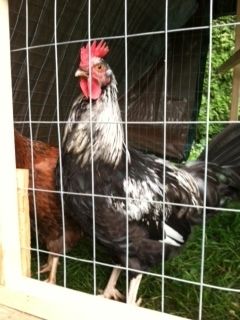Hey April,
This is a pretty high level explanation that I tried not to make very technical. I hope it makes sense, but isn't too simplistic.
A breed is made up of a number of characteristics that stay stable over a long period of time. Within a breed, there might be some variation on a particular trait; in animals, these variations are often called varieties (or cultivars in plants). People have been breeding animals and plants for a long, long time to nail down specific breeds, and specific varieties within those breeds.
The varieties can show up when a "sport" or mutation occurs; other times people crossbreed to get some particular attribute into the gene pool on which they are working. They try to breed out the qualities they don't like, and breed in the ones they think are worthwhile.
Think of puppies: black Labradors and chocolate Labradors are both Labradors (a breed), but have two different color variations. They aren't different breeds, but we say they are different varieties. (Technically, the chocolate color is the result of a gene/allele that "dumbs down", or "softens" the black color. We call that "diluted".)
Dorkings are a very, very old breed. For at least a couple of millennia, people have been breeding chickens that were similar to Dorkings for characteristics that they found useful or attractive. For instance, we know that the original Dorking color was red (RD). The RD coloration is pretty close to the ancestral color, the "wild" or "standard" color of the very first chickens.
A long time ago, a bird with mostly Dorking characteristics hatched with different coloration; my guess is that it was probably a colored (CD), which is just a gene or so away from the RD. Somebody thought it looked cool, so they tried to get another one. People did this so many times that they ended up with a strain of bird that always produced CDs when bred with another CD. Eventually this strain became a "standard" variety.
We know that the Silver Grey Dorkings (SGDs) were bred from CDs. My guess is that the Dark Colored Dorkings (DCDs) were bred from CDs, too. I don't know the history of White Dorkings (WDs; Joseph?), but my guess is that it happened in a similar way.
I hope this helps.
This is a pretty high level explanation that I tried not to make very technical. I hope it makes sense, but isn't too simplistic.
A breed is made up of a number of characteristics that stay stable over a long period of time. Within a breed, there might be some variation on a particular trait; in animals, these variations are often called varieties (or cultivars in plants). People have been breeding animals and plants for a long, long time to nail down specific breeds, and specific varieties within those breeds.
The varieties can show up when a "sport" or mutation occurs; other times people crossbreed to get some particular attribute into the gene pool on which they are working. They try to breed out the qualities they don't like, and breed in the ones they think are worthwhile.
Think of puppies: black Labradors and chocolate Labradors are both Labradors (a breed), but have two different color variations. They aren't different breeds, but we say they are different varieties. (Technically, the chocolate color is the result of a gene/allele that "dumbs down", or "softens" the black color. We call that "diluted".)
Dorkings are a very, very old breed. For at least a couple of millennia, people have been breeding chickens that were similar to Dorkings for characteristics that they found useful or attractive. For instance, we know that the original Dorking color was red (RD). The RD coloration is pretty close to the ancestral color, the "wild" or "standard" color of the very first chickens.
A long time ago, a bird with mostly Dorking characteristics hatched with different coloration; my guess is that it was probably a colored (CD), which is just a gene or so away from the RD. Somebody thought it looked cool, so they tried to get another one. People did this so many times that they ended up with a strain of bird that always produced CDs when bred with another CD. Eventually this strain became a "standard" variety.
We know that the Silver Grey Dorkings (SGDs) were bred from CDs. My guess is that the Dark Colored Dorkings (DCDs) were bred from CDs, too. I don't know the history of White Dorkings (WDs; Joseph?), but my guess is that it happened in a similar way.
I hope this helps.
Last edited:



 I've kinda been lusting after some Spangleds... even if they aren't recognized anywhere.
I've kinda been lusting after some Spangleds... even if they aren't recognized anywhere. 








